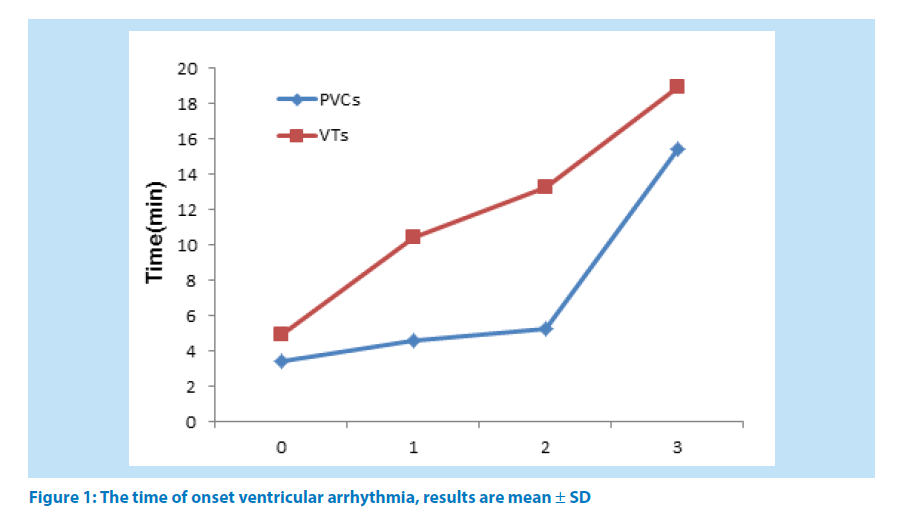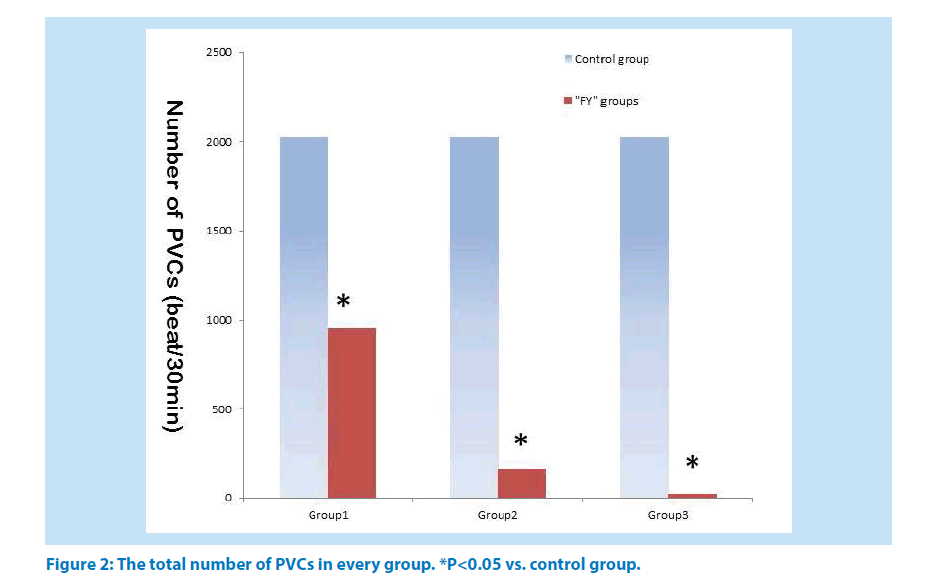Research Article - Pharmaceutical Bioprocessing (2016) Volume 4, Issue 6
Observation Study of Antiarrhythmic Effect of “FuYun”, a Multiherb Prescription for Ventricular Arrhythmias, in Isolated Rat Hearts
- Corresponding Author:
- Ying Liu
Department of Cardiology
General Hospital of Chinese People’s Liberation Army
100853 Beijing China
E-mail: shanzl@sina.com
Qian Hou
Department of Cardiology
General Hospital of Chinese People’s Liberation Army
100853 Beijing China
E-mail: shanzl@sina.com
Abstract
Keywords
aFuYun, ouabain, arrhythmia, isolated rat hearts
Introduction
Herb medicine, especially multiherb prescriptions with a long history in China, is a cost-effective therapy for many diseases, such as Artemisinine for diarrhea [1,2], Glycyrrhizae for cough [3], and Jude-screen powder (Yupingfeng San) for some respiratory diseases [4,5]. Due to their extensive use and the optimistic therapeutic efficacy and safety, multiherb medicine plays an increasing important role in health maintenance all over the world [6-8], though the exact mechanisms of action of herbal products haven’t been explicit. “FuYun” is a multiherb medicine for heart palpitations, effective and safe. We found it occasionally. Patients with symptomatic premature ventricular constractions(PVCs) who had failed to therapies with currently available conventional antiarrhythmic drugs or had some pro-arrhythmic effects turned to traditional Chinese medicine (TCM), which had an unexpected effect on inhibition of palpitations. Palpitations, belonging to the domain of TCM, are described as uncomfortable sensations of irregular beats of the heart. Any type of tachyarrhythmias can give rise to palpitations, no matter whether there is an structural heart disease or not. Thus “FuYun” triggered interests to test whether it exhibits any antiarrhythmic effects. The goal of present study is to testified the antiarrhythmic effect of “FuYun” in ouabain-induced arrhythmia in isolated rat hearts and discuss the probable underlying mechanism.
Materials and Methods
Extraction of “FuYun”
The extraction procedure of “FuYun” as follow[9]: The proprietary standard operating procedures for “FY”, the extract of “FuYun”, used hot water extraction(80℃). The hot water extract was then spray dried with insoluble dextran into a granulated powder, packaged and stored at 4 ℃. The dried “FY” powder was dissolved in 80℃ water (100mg: 1mL). The mixture was vortexed for 1 min, and then placed in water bath at 80℃ for 30 min with 1 min of vortexing for every 10 min. The sample was then cooled in an ambient temperature water bath for 5 min,centrifuged for 10 min at 10000 rpm. The sediment was filtered out sterilizedly(0.2μm), reserving the supernatant for animal experiments.
Groups and Solutions
A total of 32 SD rats were randomly divided into four groups. Group 1, control group, hearts received no pre-administration with “FY” before perfusion with ouabain. The perfusion procedure was as follows, normal Krebs solution for 20 min, and then Krebs solution with ouabain (1mM) for 30 min. Group 2, Low-“FY” group, hearts received pre-administration with “FY” of low concentration. The perfusion procedure was as follows, normal Krebs solution for 20 min, Krebs solution with “FY” of low concentration (20/9mL extract in 1000mL Krebs solution) for 30 min, and then Krebs solution with “FY” of low concentration and ouabain (1mM) for 30 min. Group 3, Mid-“FY” group, hearts received pre-administration with “FY” of middle concentration. The perfusion procedure was as follows, normal Krebs solution for 20 min, Krebs solution with “FY” of middle concentration (20/3mL extract in 1000mL Krebs solution) for 30 min, and then Krebs solution with “FY” of middle concentration and ouabain (1mM) for 30 min. Group 4, High-“FY” group, hearts received pre-administration with “FY” of high concentration. The perfusion procedure was as follows, normal Krebs solution for 20 min, Krebs solution with “FY” of high concentration (20mL extract in 1000mL Krebs solution) for 30 min, and then Krebs solution with “FY” of high concentration and ouabain (1mM) for 30min. The composition of Krebs solution was as follows (mM): NaCl 118.0, KCl 3.5, KH2PO4 1.0, NaHCO3 25.0, glucose 11.1, EDTA 0.004, MgCl2 1.6, CaCl2 1.8. The Krebs solution was oxygenated modified before perfusion, and 36– 37℃ and pH 7.4.
Heart Isolation and Langendorff
Hearts were isolated from rats conforming to previous studies[10,11]. SD rats (male,250- 350g) were anesthetized with intraperitioneal injection of sodium pentobarbital (mg/kg) after heparin injection (U/kg). Briefly, the chest was opened, and the heart was excised and suspended on the pipe through ascending aorta, to receive retrograde perfusion in Langendorff equipment.
Statistical analysis
Data are expressed as mean ± S.D. Statistical differences are evaluated by analysis of variance using SPSS statistical software (version 17.0; SPSS Inc., Chicago, IL). P<0.05 is considered as statistically significant.
Results
Effect on the time of onset of arrhythmia
Ouabain alone (1mM) produced PVCs after 3.46±1.31min and VTs at 5.00±2.49min in isolated rat hearts. Pre-administration with “FY” caused a significant prolongation in the mean time of onset of PVCs and VTs in a concentration-dependent manner (P<0.05, versus control group, Figure 1). Especially, the pre-administration with “FY” of high concentration increased the onset of PVCs to 15.44±10.44 min (P=0.001,versus control group), and VTs occurred at 18.96±10.49min ( P=0.009, versus control group).
Effect on the quantity of arrhythmic beats
After 30 min retrograde perfusion with ouabain, smaller numbers of PVCs were observed in “FY” groups than in control group (Figure 2). The number of PVCs was 2032±1050 beats/30min in control group, 955±794 beats/30min in Low- “FY” group, 166±178 beats/30min in Mid-“FY” group, and 25±35 beats/30min in High-“FY” group, respectively. In addition, this effect was concentration-dependent.
Discussion
“FuYun”, composed of Polygala tenuifolia Willd (PT), Radix Ophiopogonis (RO), Fructus Schisandrae (FS) and Fructus Gardeniae (FG), is a multiherb formula for palpitations in China.
It shows outstanding efficacy for palpitations in TCM therapy. It was observed in our study that “FY” not only significantly prolonged the time of onset of ouabain-induced ventricular arrhythmia, but also produced an unexpected decrease in the proportion of arrhythmic beats.
Ouabain is widely used to produce steady arrhythmic models for screening novel antiarrhythmic drugs. Toxic dosage ouabain inhibits Na+/K+-ATPase on the myocardial membrane, elevating intracellular Na+ concentration. The excess intracellular Na+ concentration disturbs the normal Na+-Ca2+ exchange, causing intracellular Ca2+ overload, which leads to another Ca2+ overload in sarcoplasmic reticulum (SR). The SR-Ca2+ overload is linked to delayed after depolarizations (DADs), which, if sufficiently strong, may approach threshold and produce spontaneous action potentials, leading ventricular arrhythmias[12-14].
The effect of “FuYun” on the suppression of ouabain-induced arrhythmia may lie in inhibiting ionic currents, like Ca2+ current, and then preventing the Ca2+ overload in both intracellular and SR. Moreover, it performed some capacity to stabilize the action of myocardial membrane through underlying mechanisms. The major causes of ventricular arrhythmias contain triggered activity (TA), early afterdepolarization (EAD) and delayed afterdepolarization (DAD). It has been identified in isolated myocytes that the increase or reactivation of ICa, L contribute to the afterdepolarization, while the EADs and TAs could be suppressed by inhibiting ICa, L. It has been proved that methyl 3,4,5-trimethoxycinnamate (M-TMCA), a bioactive extract from roots of PT, showed some potential anti-arrhythmic effects. M-TMCA significantly attenuated action potential duration (APD) of cardiomyocytes through inhibition of L-type calcium current (ICa, L) without affecting outward K+ currents in a reversible and a dosedependent manner. In addition, M-TMCA inhibits the intracellular Ca2+ transient induced by Isoprenaline and BayK8644, and thus may abolished the positive staircase effect of Ca2+ transient[15].
“FuYun” is a multiherb medicine and contains a multiple of components. It is a hard work to distinguish the exact antiarrhythmic components and its underlying antiarrhythmic mechanism, but it deserves further exploration because of its potential antiarrhythmic effects.
Several limitations in the present study should be mentioned. Firstly, it failed to further exploration on a cellular and ionic level. The exact antiarrhythmic mechanism is unknown. We just take SD rats as arrhythmic models, moreover, the number of samples was insufficient. We have designed another related study to explore the underlying antiarrhythmic mechanism of “FuYun”.
Conclusion
The present work indicates that “FuYun” exhibits potential antiarrhythmic effects, probably through inhibition of ionic channels to decrease ouabain-induced arrhythmia.
Competing interests
There are no potential conflicts of interest to declare.
Acknowledgment
This work was supported by grants from the Clinical Research Supportive Fund General Hospital of Chinese People’s Liberation Army (No. 2013FC-CXYY-300).
References
- Hu D, Wang Y, Chen Z. Artemisinin protects against dextran sulfate-sodium-induced inflammatory bowel disease, which is associated with activation of the pregnane X receptor. Eur J Pharmacol. 738:273-284 (2014).
- Sato A, Hiramoto A, Morita M. Antimalarial activity of endoperoxide compound 6-(1,2,6,7-tetraoxaspiro[7.11]nonadec-4-yl)hexan-1-ol. Parasitol Int. 60:270-273 (2011).
- Kamei J, Saitoh A, Asano T. Pharmacokinetic and pharmacodynamic profiles of the antitussive principles of Glycyrrhizae radix (licorice), a main component of the Kampo preparation Bakumondo-to (Mai-men-dong-tang). Eur J Pharmacol. 507:163-168 (2005).
- Cui W, Li L, Li D. Total glycosides of Yupingfeng protects against bleomycin-induced pulmonary fibrosis in rats associated with reduced high mobility group box 1 activation and epithelial-mesenchymal transition. Inflamm Res. 64:953-961 (2015).
- Makino T, Ito Y, Sasaki SY, Fujimura Y, Kano Y. Preventive and curative effects of Gyokuheifu-san, a formula of traditional Chinese medicine, on allergic rhinitis induced with Japanese cedar pollens in guinea pig. Biol Pharm Bull. 27:554-558 (2004).
- Kirichenko TV, Sobenin IA, Nikolic D, Rizzo M, Orekhov AN. Anti-cytokine therapy for prevention of atherosclerosis. Phytomedicine. 2015.
- Li L, Dou L, Leung PC, Chung TK, Wang CC. Chinese herbal medicines for unexplained recurrent miscarriage. Cochrane Database Syst Rev.1:CD010568 (2016).
- Hsieh CH, Tsai HC, Hsu GL, Chen CC, Hsu CY. Herb formula enhances treatment of impotent patients after penile venous stripping: a randomised clinical trials. Andrologia. 2015.
- Tilton R, Paiva AA, Guan JQ. A comprehensive platform for quality control of botanical drugs (PhytomicsQC): a case study of Huangqin Tang (HQT) and PHY906. Chin Med. 5:30 (2010).
- Dianat M, Hamzavi GR, Badavi M, Samarbaf-zadeh A. Effect of vanillic acid on ischemia-reperfusion of isolated rat heart: Hemodynamic parameters and infarct size assays. Indian J Exp Biol. 53:641-646 (2015).
- Ma H, Zhou J, Shang E. Interactions between bufadienolides derived from toad venom and verapamil in langendorff-perfused guinea-pig hearts. Toxicol In Vitro. 27:396-401 (2013).
- Zhou Y, Wu Y, Deng L. The alkaloid matrine of the root of Sophora flavescens prevents arrhythmogenic effect of ouabain. Phytomedicine. 21:931-935 (2014).
- Sipido KR, Volders PG, Schoenmakers M. Role of the Na/Ca exchanger in arrhythmias in compensated hypertrophy. Ann N Y Acad Sci. 976:438-445(2002).
- Aronsen JM, Skogestad J, Lewalle A, et al. Hypokalaemia induces Ca(2+) overload and Ca(2+) waves in ventricular myocytes by reducing Na(+),K(+)-ATPase alpha2 activity. J Physiol. 593:1509-1521 (2015).
- Zhao Z, Fang M, Xiao D, et al. Potential antiarrhythmic effect of methyl 3,4,5-trimethoxycinnamate, a bioactive substance from roots of polygalae radix: suppression of triggered activities in rabbit myocytes. Biol Pharm Bull. 36:238-244 (2013).




